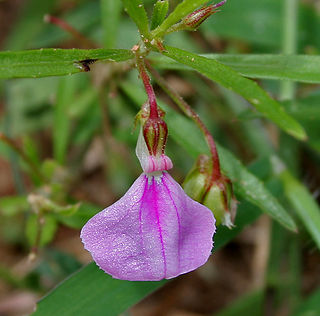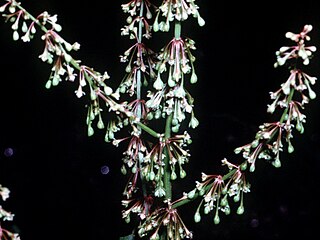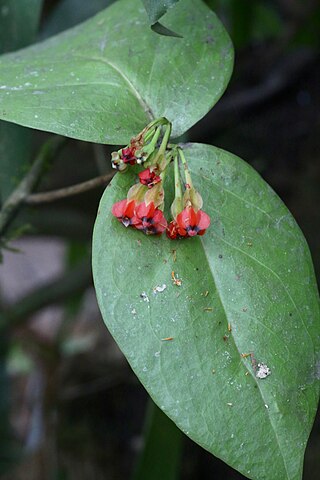
Helianthus is a genus comprising about 70 species of annual and perennial flowering plants in the daisy family Asteraceae commonly known as sunflowers. Except for three South American species, the species of Helianthus are native to North America and Central America. The best-known species is the common sunflower. This and other species, notably Jerusalem artichoke, are cultivated in temperate regions and some tropical regions, as food crops for humans, cattle, and poultry, and as ornamental plants. The species H. annuus typically grows during the summer and into early fall, with the peak growth season being mid-summer.

Leucopogon verticillatus, commonly known as tassel flower, is a species of flowering plant in the heath family Ericaceae and is endemic to the southwest of Western Australia. It is an erect, bamboo-like shrub with broadly lance-shaped leaves and pink, tube-shaped flowers crowded along spikes in leaf axils and on the ends of branches.

Plectranthus verticillatus, Swedish ivy, Swedish begonia or whorled plectranthus is a plant in the family Lamiaceae (Labiatae), genus Plectranthus. Despite its common name, it is not close to the ivy family of the genus Hedera.

Rhynchospermum is a genus of flowering plants within the tribe Astereae within the family Asteraceae.

Xanthostemon is a genus of plants in the myrtle family Myrtaceae, first described in 1857 by the German–born Australian botanist Ferdinand von Mueller. The genus is distributed across Malesia, Papuasia and northern Australia. The genera Pleurocalyptus and Purpureostemon from New Caledonia are morphologically close to Xanthostemon.

Hybanthus (green-violet) is a genus of flowering plants in the family Violaceae. This genus name is Greek for "humpback flower", referring to the drooping pedicels of plants that are part of this genus. The genus is grossly polyphyletic and may contain up to nine different genera, of which Pombalia Vand., Cubelium Raf. and Pigea DC. have been previously recognised.
Creeping charlie is a common name for several species of flowering plants:

Acanthocarpus is a genus in the family Asparagaceae, subfamily Lomandroideae, in the APG III system of classification. It has been difficult to place at family rank, being placed at various times in Dasypogonaceae as well as the Asparagaceae. The entire genus is endemic to the State of Western Australia.
Ixophorus is a genus of Latin American plants in the grass family. The only recognized species is Ixophorus unisetus. Some authors have included one or two other species in the genus, such as I. pringlei, but these have more recently been reduced to synonymy. Common names for I. unisetus include crane grass, turkey grass, Honduras grass, Mexican grass, Central America grass, hático (Colombia), zacate blanco, and zacate chompipe (Nicaragua).

Decodon verticillatus, the sole living species in the genus Decodon, is a flowering plant in the family Lythraceae. It is commonly known as waterwillow or swamp loosestrife. It is native to wetlands in the eastern half of the United States and Canada.
The water-willow stem borer is a moth of the family Noctuidae. Its larvae tunnel into the stems of the water-willow plant and it is found in the parts of the eastern United States where this plant grows.

Xanthostemon verticillatus is a species of trees from the plant family Myrtaceae endemic to the Wet Tropics rainforests of northeastern Queensland.
Leavenworthia crassa is a species of flowering plant in the mustard family, Brassicaceae, known commonly as the fleshy-fruit gladecress. It is endemic to Alabama in the United States, where it occurs in only two counties. It is "likely one of the most imperiled plant species in the Southeast," and the United States Fish and Wildlife Service issued a final rule listing it as an endangered species in 2014.
Lindsay Stuart Smith was an Australian botanist, naturalist and public servant.
Jennifer R. Mandel is an American biologist. Mandel is an associate professor of biological sciences at the University of Memphis.

Rumex verticillatus, also known as swamp dock, is a species of perennial flowering plant in the family Polygonaceae. Rumex verticillatus is native to, and almost entirely found in, the eastern half of North America. It is common to find this plant in edges of vernal pools and streams in woodlands, swamps, soggy islands in partially shaded areas, marshes, and roadside ditches.
Rumex floridanus is a perennial flowering plant, in the family Polygonaceae. The common name for this species is Florida dock.

Anthopterus is a genus of flowering plants belonging to the family Ericaceae.










